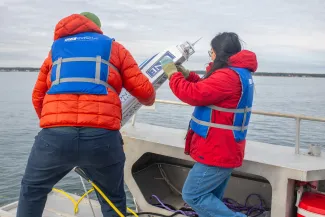
The device aims to fill crucial gaps in data about changes to Maine’s oceans and connect a network of ocean scientists across the globe
The sun was low in the sky and the waves calm early on Monday, Nov. 3, as a crew of students and researchers from the University of New England departed the University’s dock, braving the morning chill to lower a slender white buoy into the cold waters of the Gulf of Maine.
Less than an hour later, as the vessel drifted back toward land, the buoy’s sensors came to life, streaming data that, for the first time, would allow UNE scientists to monitor the rhythm of the sea in real time, filling crucial information holes about changes to Maine’s oceans in a time of rapid physical and ecological change.


(Left): Student and faculty researchers gather on UNE’s research dock. (Right): UNE senior Jasmin Townsend-Ng (’26) assists Dr. Will Kochtitzky in lowering the research buoy into the Gulf of Maine.
The buoy, equipped with a full suite of oceanographic monitoring tools, measures wave properties, ocean currents, dissolved oxygen, and temperature at multiple depths.
According to project lead Will Kochtitzky, Ph.D., the next-closest buoy of its kind is located about 10 nautical miles to the northeast and further offshore.
Kochtitzky, an assistant professor in the School of Marine and Environmental programs, said the new device complements the existing buoy by providing even better data to inform conditions for more southern communities, including Camp Ellis across the Saco River from UNE, which has been devastated by powerful storms for over a century, including the loss of dozens of homes.
It’s a great feeling to know that I can be part of something so much bigger than myself.” — Elizabeth O’Brien ’29
Positioned at the heart of one of the most rapidly shifting marine ecosystems on Earth, the UNE buoy joins a network of instruments that includes a full-spectrum weather station on the University’s own Ram Island, a private research station complete with real-time meteorological and seismic-tracking equipment capable of recording the environmental changes reshaping Maine’s coast.
“The Gulf of Maine is changing faster than almost anywhere else on the planet, and we’re seeing that reflected in everything from fisheries to coastal infrastructure,” Kochtitzky said. “By expanding our observation network in southern Maine, we can help local planners and policymakers make informed decisions to improve resilience across coastal communities.”

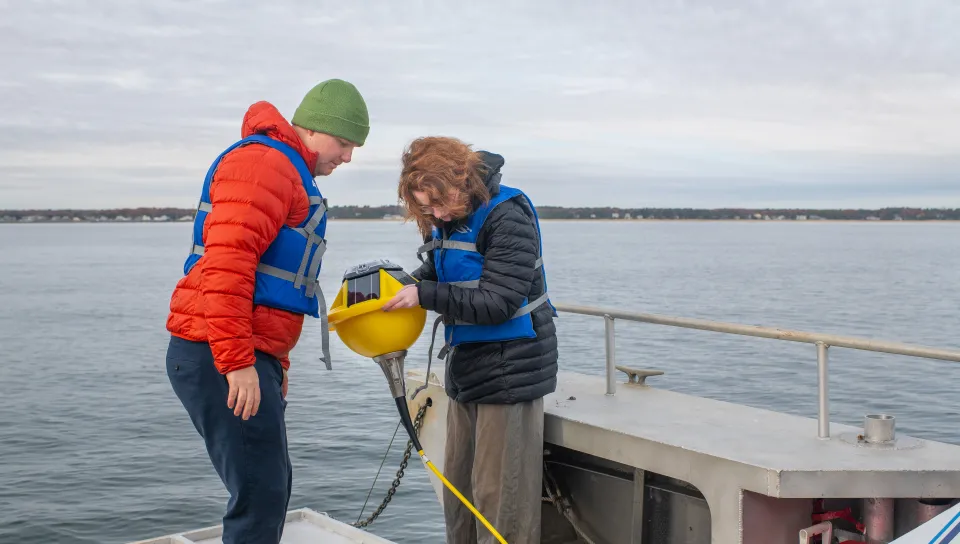
Elizabeth O’Brien (’29) played a crucial role in ensuring the maritime sensors’ functionality throughout the project in her first semester of study.
Funded by Maine-SMART, a National Science Foundation award to the University of Maine, the deployment marked another milestone in UNE’s ongoing buildout of its ocean research infrastructure to inform and promote the resiliency of coastal communities amid rising sea levels and increasingly powerful storms.
The project was also developed in close partnership with SOS Saco Bay — a community group focused on coastal resilience in the shoreside municipalities of Biddeford, Saco, Old Orchard Beach, and Scarborough — who served as a co-investigator on the grant award.
We’re preparing the next generation of … a workforce that is necessary to protect the health of Maine’s coastal communities, economies, and ways of life.” — Will Kochtitzky, Ph.D.
Installation was carried out in Saco Bay, just offshore of Camp Ellis, by student researchers from UNE’s marine sciences programs, with guidance from faculty and innovators from the University’s School of Marine and Environmental Programs and Center for Innovation and Entrepreneurship (CIE).
For many of the students, the project is part of the formative research experiences that UNE fosters from their very first semester. These include Elizabeth O’Brien (Marine Sciences, ’29), who was drawn to UNE for its diverse, experiential learning opportunities — despite the number of renowned marine biology programs around her Baltimore-area hometown on Chesapeake Bay.
“My first lab at UNE was going on a boat to Ram Island, and it made me realize I made the right choice coming to UNE, where I can customize my major to be exactly what I want it to be,” she said. “To be out here today so early on in my major — it’s a great feeling to know that I can be part of something so much bigger than myself.”
of UNE undergrads engage in research — double the national average
UNE’s marine science programs ranked among the best in the country
Such experiences underscore UNE’s focus on hands-on learning and professional readiness early on in their educational journeys. Forty-six percent of UNE undergraduates engage in faculty-led research — more than double the national average — and UNE’s marine sciences degree programs are ranked among the top 10 in the nation.
The data transmitted from the new buoy feeds directly into the UNE’s new Sustainable Innovation Center (SIC), operated by the CIE, where researchers can visualize wave and weather data in real time, turning raw numbers into insights that drive both research and innovation.
As the buoy settled into place offshore, nestled at depths down to 50 feet on the ocean floor, its sensors began their constant relay of readings, streaming directly to the SIC — and to computers around the world.
Over the coming months, researchers will analyze seasonal patterns and extreme weather events captured by the buoy, with findings expected to inform regional coastal management and resilience strategies.
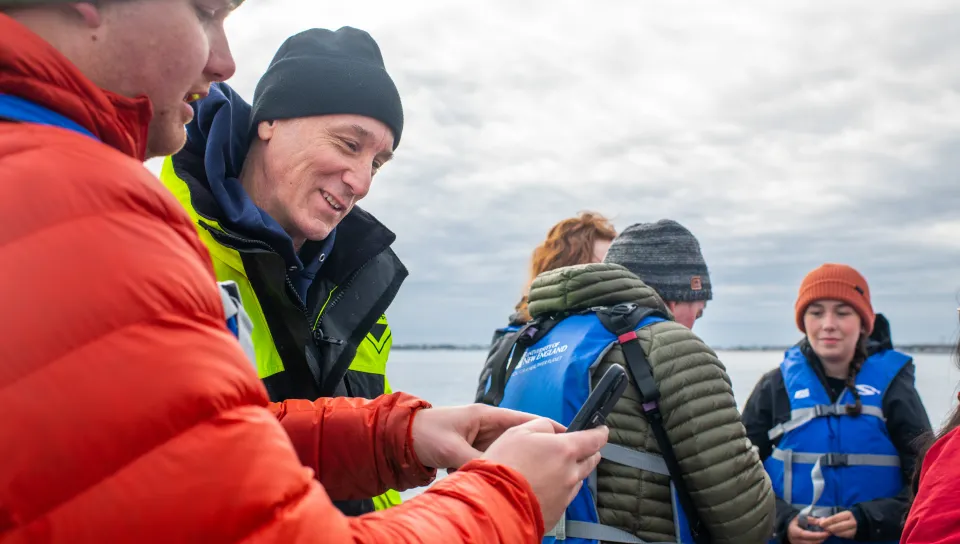

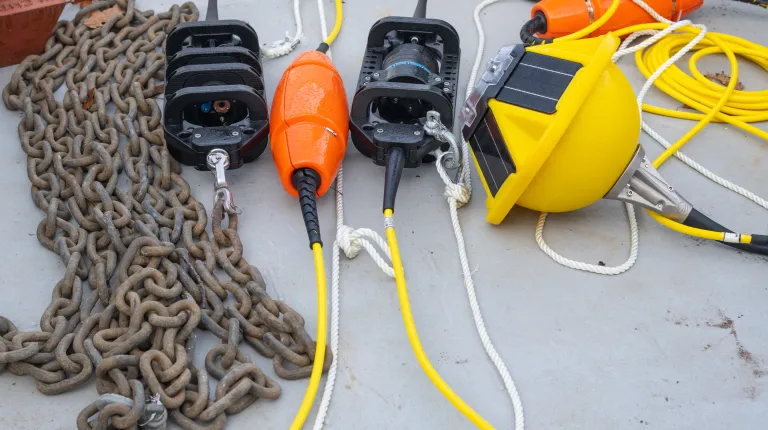
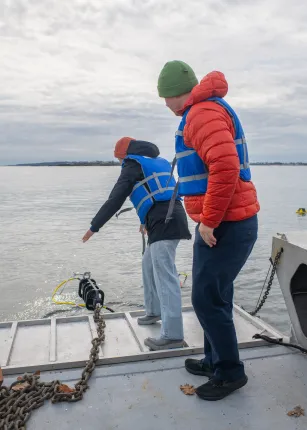

(Clockwise, from top left): Kochtitzky views data on his smartphone; Lexi De Gree (’29) and Townsend-Ng celebrate the buoy’s launch; UNE pilot Tim Arienti gives the “OK” to signal success; De Gree helps drop anchor; and the full display of data sensors.
Kochtitzky said the stream of data is more than an academic exercise — it’s an investment in Maine’s sustainable future, preparing students to enter the workforce equipped with the skills to solve real-world problems in science, business, health, and public knowledge, Kochtitzky noted.
“Our students are building the very tools that help us understand how the planet is changing,” he said. “Through their work, we’re not only gathering critical data; we’re preparing the next generation of scientists and innovators who will lead the response to those changes and grow a workforce that is necessary to protect the health of Maine’s coastal communities, economies, and ways of life.”

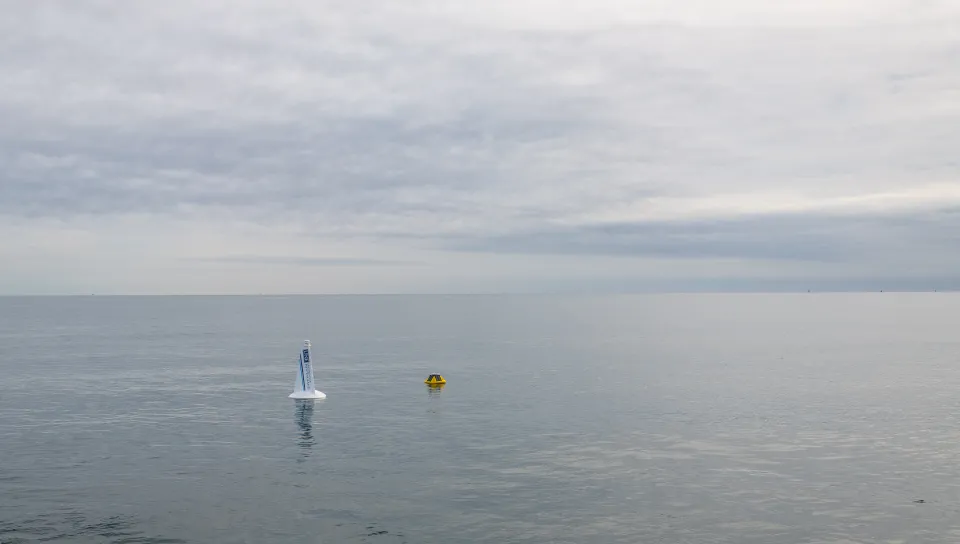
(Left): O’Brien, De Gree, and Townsend-Ng. (Right): The buoy now sits in Saco Bay, recording and transmitting data to researchers the world over.
O’Brien, who was one of two first-year students aboard the vessel on Monday, said she was proud to be part of the landmark development in advancing UNE’s mission of improving the health of communities and the natural world.
“To use the skills and knowledge I’m gaining from such a young age is very powerful,” O’Brien said, with the Saco River Estuary as a backdrop. “I hope this work inspires people to do the same and push for these efforts to protect our coasts, our climate, and the ocean and everything that’s a part of it.”
View front-page media coverage of this landmark research in the Portland Press Herald, Morning Sentinel/Kennebec Journal, Sun Journal, WMTW News 8, WGME CBS 13, and Saco Bay News